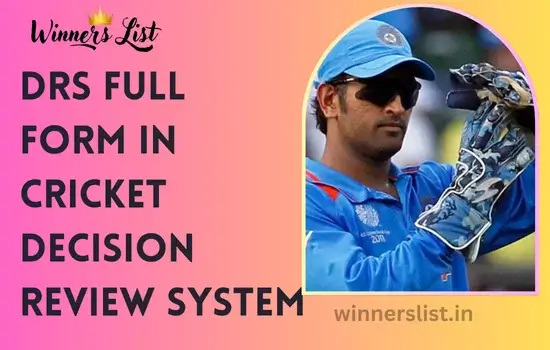In the dynamic world of cricket, the Decision Review System (DRS) stands as a pivotal innovation that has revolutionized the game’s adjudication process. DRS offers teams a lifeline to challenge on-field decisions, providing a mechanism for fair play and enhancing the accuracy of umpiring decisions. Let’s delve into the intricacies of DRS, unraveling its full form and exploring its impact on the modern game of cricket.

DRS – Decision Review System:
DRS is a technology-driven system implemented in cricket to assist umpires in making accurate decisions on the field. It comprises various technological tools, including ball-tracking technology (Hawk-Eye), infra-red cameras (Hot Spot), and audio sensors (Snickometer), to analyze and review contentious decisions during a match.
Full Form and Components:
DRS stands for the Decision Review System, encompassing multiple components that aid umpires in decision-making. These components include ball-tracking technology, which predicts the trajectory of the ball, Hot Spot, which detects heat generated by friction, and Snickometer, which detects sound vibrations to determine whether the ball has touched the bat or pad.
Usage and Challenges:
Teams are granted a limited number of reviews per innings to challenge on-field decisions using DRS. However, the system is not without its challenges. Factors such as technology limitations, human error, and subjective interpretation can impact the accuracy of DRS decisions. Additionally, teams must use their reviews judiciously, as unsuccessful reviews can result in penalties.
Impact on Umpiring and Fair Play:
The introduction of DRS has had a significant impact on umpiring standards and fair play in cricket. It provides umpires with additional tools to make informed decisions, reducing the margin of error and enhancing the integrity of the game. DRS has also led to increased scrutiny of umpiring decisions, fostering accountability and transparency in officiating.
Table:
| Heading | Article about DRS (Decision Review System) |
|---|---|
| Full Form and Components | DRS comprises various technological tools like ball-tracking, Hot Spot, and Snickometer to assist umpires in decision-making. |
| Usage and Challenges | Teams are granted limited reviews per innings, but factors like technology limitations and human error pose challenges to the system. |
In summary, the Decision Review System (DRS) represents a significant milestone in cricket’s evolution, offering a blend of technology and tradition to uphold the principles of fair play and accuracy in umpiring decisions.

Hello, I’m Kapil Kumar, a seasoned SEO expert and blogger at WinnersList.in. My mission is to spotlight exceptional individuals and organizations across various domains. Through curated lists, profiles, and inspiring stories, I aim to celebrate outstanding achievements and inspire the next generation of champions. Join me in this journey.
